Small overlap front: driver-side
Rating applies to 2007-10 models
Tested vehicle: 2012 Dodge Avenger SE 4-door
The Dodge Avenger was introduced in the 2008 model year as a replacement for the Dodge Stratus, which was discontinued after the 2006 model year. The Chrysler Sebring sedan was redesigned for the 2007 model year. Both cars were restyled beginning with the 2011 model year, and the Sebring was renamed the 200.
| Evaluation criteria | Rating |
|---|---|
| Structure and safety cage | |
| Driver injury measures | |
| Head/neck | |
| Chest | |
| Hip/thigh | |
| Lower leg/foot | |
| Driver restraints and dummy kinematics The dummy’s head barely contacted the frontal airbag before sliding off the left side, leaving the head vulnerable to contact with forward side structure. The side curtain airbag deployed too late during the crash, after the head had moved to the left, outboard of the inflating curtain, leaving the dummy's head vulnerable to contact with side structure and outside objects. The small side torso airbag deployed. | |
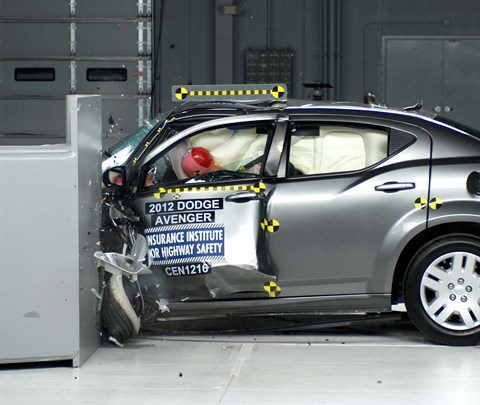
Action shot taken during the small overlap frontal crash test.
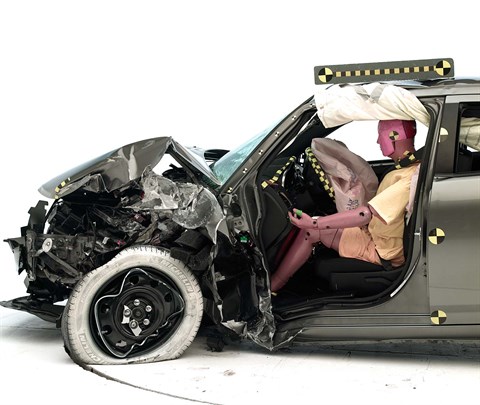
The dummy's position in relation to the door frame, steering wheel, and instrument panel after the crash test indicates that the driver's survival space was maintained reasonably well.
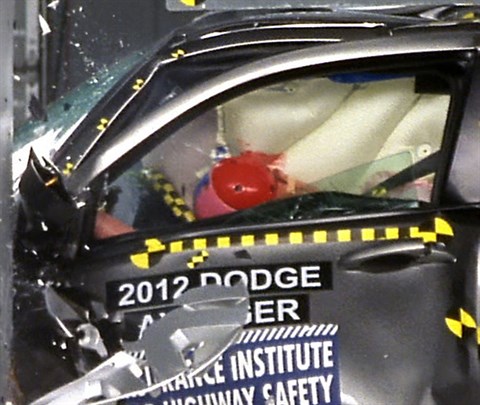
During the crash, the dummy's head barely contacted the frontal airbag before sliding off to the left, and the side curtain airbag deployed too late to offer any head protection, leaving the dummy's head exposed to contact with side structure and outside objects.
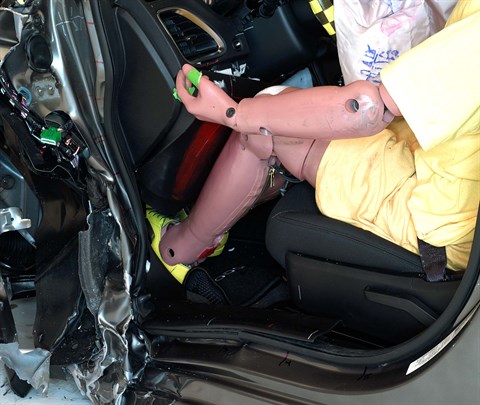
Except for door hinge pillar deformation, intrusion into the driver's space was reasonably well controlled, and risk of injuries to the dummy's legs and feet was low.
Moderate overlap front: original test
Rating applies to 2007-10 models
Tested vehicle: 2008 Dodge Avenger SXT 4-door
The Dodge Avenger was introduced in the 2008 model year as a replacement for the Dodge Stratus, which was discontinued after the 2006 model year. The Chrysler Sebring sedan was redesigned for the 2007 model year. Both cars were restyled beginning with the 2011 model year, and the Sebring was renamed the 200.
| Evaluation criteria | Rating |
|---|---|
| Overall evaluation | |
| Structure and safety cage | |
| Driver injury measures | |
| Head/neck | |
| Chest | |
| Leg/foot, left | |
| Leg/foot, right | |
| Driver restraints and dummy kinematics | |
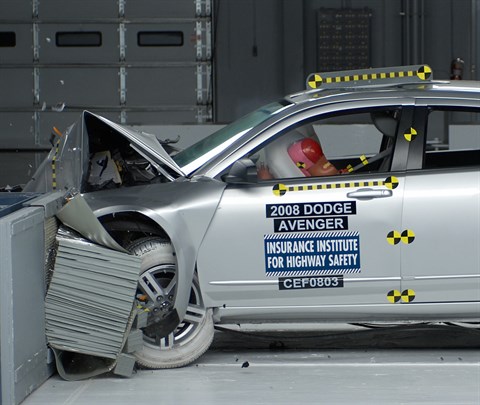
Action shot taken during the frontal offset crash test.
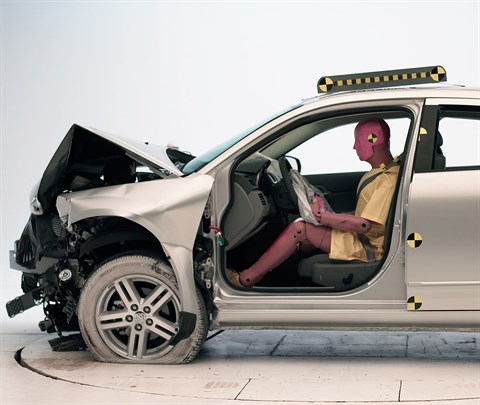
The dummy's position in relation to the steering wheel and instrument panel after the crash test indicates that the driver's survival space was maintained well.
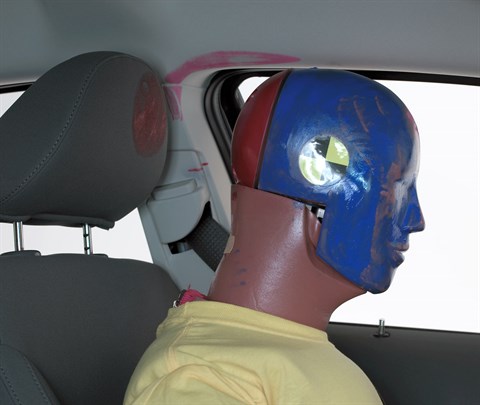
Smeared greasepaint indicates where the dummy's head hit the roof rail, B-pillar, and head restraint during rebound. Head accelerations from these hits were low.
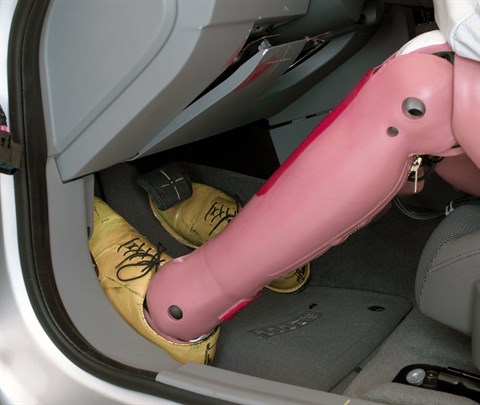
Intrusion into the driver's space was minimal, and all leg and foot injury measures were low.
Side: original test
Rating applies to 2007-10 models
Tested vehicle: 2008 Dodge Avenger SXT 4-door with standard front and rear head curtain airbags and standard front seat-mounted torso airbags
The Dodge Avenger was introduced in the 2008 model year as a replacement for the Dodge Stratus, which was discontinued after the 2006 model year. The Chrysler Sebring sedan was redesigned for the 2007 model year. Both cars were restyled beginning with the 2011 model year, and the Sebring was renamed the 200.
| Evaluation criteria | Rating |
|---|---|
| Overall evaluation | |
| Structure and safety cage | |
| Driver injury measures | |
| Head/neck | |
| Torso | |
| Pelvis/leg | |
| Driver head protection | |
| Rear passenger injury measures | |
| Head/neck | |
| Torso | |
| Pelvis/leg | |
| Rear passenger head protection | |
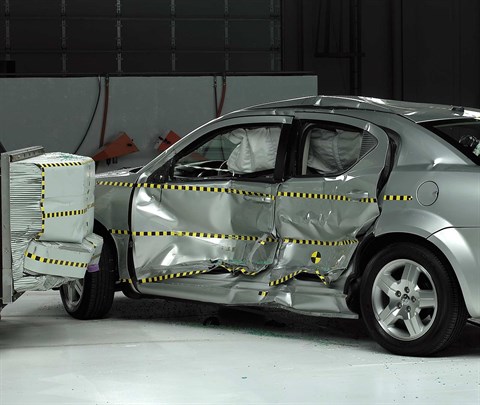
View of the vehicle and barrier just after the crash test.
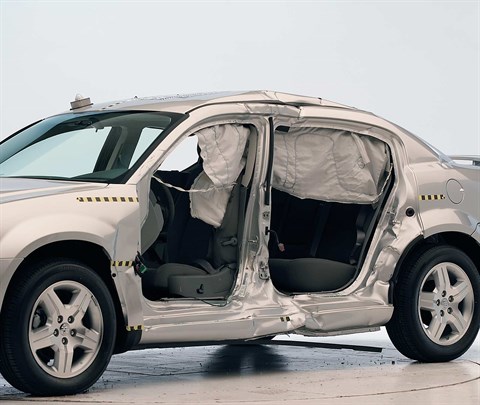
View of the vehicle after the crash with doors removed, showing the side airbags and damage to the occupant compartment.

Smeared greasepaint shows where the driver dummy's head was protected from being hit by hard structures by the side airbags.
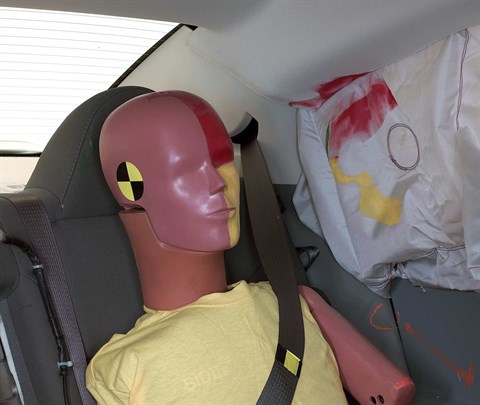
Smeared greasepaint shows where the rear passenger dummy’s head was protected by the side airbag.
Roof strength
Rating applies to 2007-10 models
Tested vehicle: 2009 Dodge Avenger SXT 4-door
| Overall evaluation | |
|---|---|
| Curb weight | 3,275 lbs |
| Peak force | 14,508 lbs |
| Strength-to-weight ratio | 4.43 |
Head restraints & seats
Seat type: Power cloth seats with manual lumbar AHR
| Overall evaluation | |
|---|---|
| Dynamic rating | |
| Seat/head restraint geometry |
About the head restraint & seat test
Currently, IIHS tests apply only to front seats.
